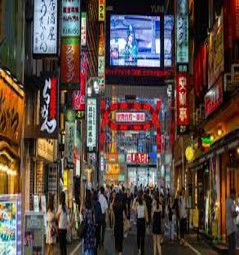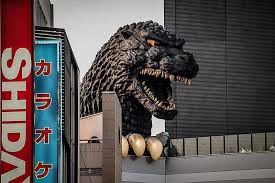4. Shinjuku-East

Shinjuku-East by Andrew Guthrie-Dow
The combo-word “red-light-district”, or “red-area”, is used to describe a range of neighbourhoods. When I use the term, I always think of it as a positive place where anyone who feels alienated from society, like working girls-and-boys whether cis-or-trans, gays, transvestites (like me), and others, can work and play in a safe, fun and controlled environment of streets, bars, clubs, shops and restaurants. I feel the red-area in Amsterdam fulfils these requirements. What I do not mean is a seedy, dangerous and exploitative place where sex-workers can be picked-up, often on locally-notorious roads.
The Kabukicho area in Shinjuku-East is referred to as a red-area. It lies immediately to the east of the tracks leading out of the mega-railway-station of Shinjuku, in the heart of Tokyo. It was never my plan to go there when I had the consulting-opportunity in the late 90’s to visit Japan for the first time, it’s just that I was sent there! I was actually sent there! The end-client, a US based life-sciences company, had set-up their Japanese subsidiary in an office-block adjacent to Kabukicho, so for my short-stay I was installed in a posh-hotel close-by. They could have had an office anywhere in Tokyo, but no, it was in Shinjuku-East. Sometimes I feel a mysterious higher-power is at work here rather than pure-chance, and if so, I thank it with all my heart for sending me to that “floating-world” of ukiyo (the pleasure-seeking lifestyle-and-culture at the end of the EDO period).
Prior to going to Shinjuku-East, the one recent Japanese “exposure” I had was when I, and my life-partner Marvella, “researched” a monthly underground play-party on Hemkade, where the old docks were about to be redeveloped. The party was underground, both figuratively and physically, as we had to climb down a ladder to get-in, all policed by the tallest bouncer I’ve ever seen. Climbing-down a ladder in full-fetish-gear is no-mean-feat, but we managed it, with only a small loss of dignity.
As soon as we “landed” on the abandoned warehouse floor, it became obvious this fetish party was at the extreme-sleazy side of the posh-sleazy spectrum. People were shooting-up, the space was populated by very-heavy people and “crims”. It was clear this was the monthly criminal get-together where Amsterdam’s underworld could meet-up and let-its-hair-down. We had zero interest in re-engaging with this sub-culture, so decided to leave as soon as we sensibly could without attracting attention. This meant circulating for a while, checking-out any scenes, then up the ladder and out.
There were two scenes in progress in separate side-spaces. The first was run by a Chinese triad. Amsterdam has a Chinese community like many port cities do, and this was where-and-how their SM was conducted, away from the general public and very much controlled by organized-crime. This explained why you seldom saw a Chinese person at an event; they had their own sub-sub-culture. Their scene also was very different and darker than the mainstream. Chinese young-ladies were tied by their wrists facing each-other, kneeling on a table, while older Chinese males orchestrated things. It was much-more like an ethnic brothel than a safe, sane and consensual fun-scene.
We moved to the second scene, and this time it was the Yakuza in charge. There is only a small but quite wealthy Japanese presence in Amsterdam, mostly concentrated in the outskirts in Amstelveen. A Japanese “kobun” (gang apprentice) was stripped to his waist revealing the amazing tattoos of his allegiance. Dragons, all that sort of thing, but what I remember were the bright colours, especially the greens. You never saw tattoos like this at the other pay-parties.
The scene itself was in the “bloodsports” genre. He had a whole selection of traditional-knives which were laid-out on a table, and he demonstrated how sharp they were by using them on himself, drawing blood from his arms. This most certainly was not Marvella’s and my fetishes, but underscored organized-crime’s involvement in Japanese SM, and just how focused it was towards the extreme. This then was what was in my mind as I landed in Narita, having flown first-class to Japan after being “bumped-up” from business, the only time this ever happened to me (FYI, I can fully recommend travelling like this on the upper deck of a 747, especially if someone else is paying).
I was only in Japan for three days, and most of my time was already booked-up by work. It was a Sunday which I used to settle-in and recover. Out of the hotel window I could see mount Fuji and wondered if you could climb it (you can at certain times of the year), but later I was told the old Japanese saying “a wise man climbs mount Fuji; a foolish man climbs it twice!”, which dissuaded me from the enterprise. The Monday-evening after work I had to spend with my hosts (part of the job being an IT-consulting), so Tuesday-evening was the only time I had to explore the red-area before returning to Amsterdam on the Wednesday.
Being in the client’s 5th-floor office re-enforced many tropes about business life there; busy, incomprehensible, with the powerbase physically centred in the middle of the open-plan floor, surrounded by support-desks, and on the outer edge by the windows with a good view over Shinjuku, workers about to retire, and visitors they didn’t know what to do with, like me! To be honest it was a bit of a freebee, a thankyou payoff for the project’s European successes, to be followed by the Japanese roll-out.
On Tuesday evening I began researching Kabukicho. It was raining continuously, but unlike in Europe, this was a warm rain. All the signs to the bars, restaurants and other establishments were in Japanese, with one exception, which stated “No Foreigners”, a friendly welcome indeed! It was still busy despite the rain with salary-workers dropping-in before their long train-rides home from the nearby Shinjuku station. Kabukicho looked quite welcoming to me, and if I was working there, I’m sure I could discover where to hang-out. After investigating every alley and cul-de-sac I found a bar that felt “right”, went in, and spent the rest of the evening in conversation with a group of office-workers on a night-out. Only one of them, a young-lady, spoke English, who then acted as translator. She said I was the only gaijin (foreigner) they had ever seen in there. Typical me; always a pioneer!
What was most different to De Wallen (the walls), Amsterdam’s equivalent, was the policing. Having lived for many years amongst the Dutch with their concept “gedogen”, I came to understand how it was done over the centuries (i.e. not every law needed to be rigorously policed). Here in Kabukicho (theatre courtyard) there were Yakuza strategically stationed at the crossroads of the alleys, very distinctive in their black-suits and shades, sometimes with a bit of their finger missing. Often there would be an imposing black-Mercedes parked next to them. This was their real-estate, controlled by the Ingawa-kai crime-gang, and in those days back in the late-90’s, they made no attempt at discretion; quite the opposite!
Fast-forward 20 years, and I’m back in Tokyo, this time with Marvella. The end-client was different too, being a processed-food giant with world-wide-operations. They didn’t put us-up in Shinjuku-East, but in Akihabara, where all the maid-cafés are located (I salute these multi-nationals; they obviously knew what their workers and visitors’ “needs” are, or was it just the dirt-cheap office-space?). We took one of Tokyo’s wonderful taxis from our hotel to Kabukicho so I could show Marvella the area and reminisce.
I was in for a shock. On the surface the red-area looked totally different. The Yakuza had disappeared from the streets, money had been spent, and God-forbid, there was a giant, twelve-metre-high Godzilla at the entrance to greet us. It now looked more like a Disney theme-park. What had they done to my sleazy, edgy red-area of old? I’m sure underneath the gloss the Yakuza were still there, alongside the “massage-parlours” and underground bars, but for me it had lost something. What’s the point of having a red-area you can bring your children to? Disney does it better.

Then it got me thinking. Was I right? Was this the way forward after all, everything in the open, no shame, no “hiding-in-the shadows”, but also perhaps, no fun? I realized then that for me, the sleaze-and-danger were inextricable intertwined with the SM sub-cultural experience. I was holding-on to a past-memory, like listening to Mark Almond’s version of “Tainted-Love” too many times, and should let-go. It would only be a matter-of-time before SM was treated like being gay, and even a children’s-TV presenter could be kinky and “out” (or perhaps not!).